Key Points
When it comes to the most popular mushrooms to buy and cook, button mushrooms and portobello mushrooms are two of the most popular. However, many people find themselves confused. Are these mushrooms the same? Are they different? What sets them apart from each other? How can you identify which is which?
This article delves into descriptions of both button mushrooms and portobello mushrooms. By the end, you should be able to describe the differences and similarities between the two and when to use one or the other.
Before we dive in, here is the bottom line: button and portobello mushrooms are the same species! That’s right! Button and portobello mushrooms are both the edible fungus known by their scientific name Agaricus bisporus. Yet if you search for an image or have experience buying button and portobello mushrooms at the store or farmers’ market, then you know that they look very different. How is that possible?
This article will help you learn about what makes button and portobello mushrooms different from each other, despite the fact that they are both the same species. Let’s go!
Comparing Button and Portobello Mushrooms
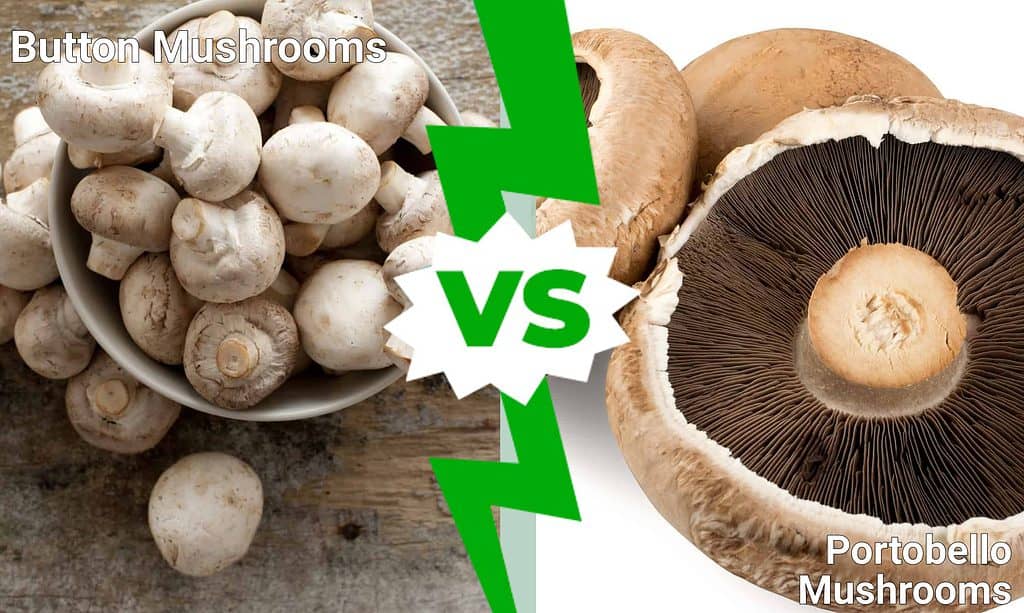
| Button Mushrooms | Portobello Mushrooms | |
|---|---|---|
| Scientific Name | Agaricus bisporus | Agaricus bisporus |
| Genus | Agaricus | Agaricus |
| Family | Agaricaceae | Agaricaceae |
| Division | Basidiomycota | Basidiomycota |
| Kingdom | Fungi | Fungi |
| Common Name | Button mushroom, white button mushroom, white mushroom | Portabella mushroom, portobella mushroom, portobello mushroom |
| Origin | The name “button mushroom” is English, with the first known use of the name in 1708. The mushroom species Agaricus bisporus is cultivated in Asia, Europe, and North America. | The name “portobello” mushroom is Italian, and is said to be named after a town in Italy by the same name. |
| Description of Fungus | The youngest mushrooms harvested are called “button mushrooms.” Button mushrooms are white, mild in flavor, and small (between half an inch and 3 inches across). | Portobello mushrooms are harvested at their full maturity. At this point, they have brown caps which can grow as big as 6 inches across! The caps have furly unfurled at that point. Their flavor is earthy and sometimes described as “meaty.” |
| Harvesting Period | Button mushrooms may be harvested after seven to 14 days of growing (after the mycelium initially sprouts). | Portobello mushrooms are usually harvested after a minimum growth period of three to four weeks. |
Description of Agaricus bisporus

Button mushrooms are consumed on a much grander scale than portobellos, with some estimates stating that as much as 90% of mushroom consumption in the U.S. is of button mushrooms.
©BGSmith/Shutterstock.com
Both button mushrooms and portobello mushrooms are the edible fungus species Agaricus bisporus, which is in the Agaricus genus. Agaricus is one of many genera in the Agaricaceae family. Among all global mushroom cultivation, the Agaricus bisporus species is one of the most popular. It also brings several of the most popular mushroom “types.” These are button mushrooms, which are harvested at the earliest stage of maturity, baby bella or crimini mushrooms, which are older but not fully mature, and portobellos, which are fully mature.
Description of Button Mushrooms
As the most immature form of Agaricus bisporus, button mushrooms are tender, mild in flavor, and very small – as tiny as the size of a fingernail, or as big as several inches across. They are typically white or pale tan in color, have rounded caps hiding brown gills, and have white stems. Button mushrooms are one of the most popular forms of Agaricus bisporus, and grow naturally. People also cultivate them to eat.
Description of Portobello Mushrooms
Portobello mushrooms are the mature form of Agaricus bisporus. As a result, they taste earthy and can carry a strong flavor. Because of that, some vegan or vegetarian cooks use portobello mushrooms as an alternative to meat. Cultivators harvest portobello mushrooms after several weeks of growth. They have brown caps, which have fully unfurled to reveal brown gills underneath, and a white or cream-colored stalk. At this point, the caps can be quite large. They range from several inches across to as big as 6 inches in diameter!
Key Differences
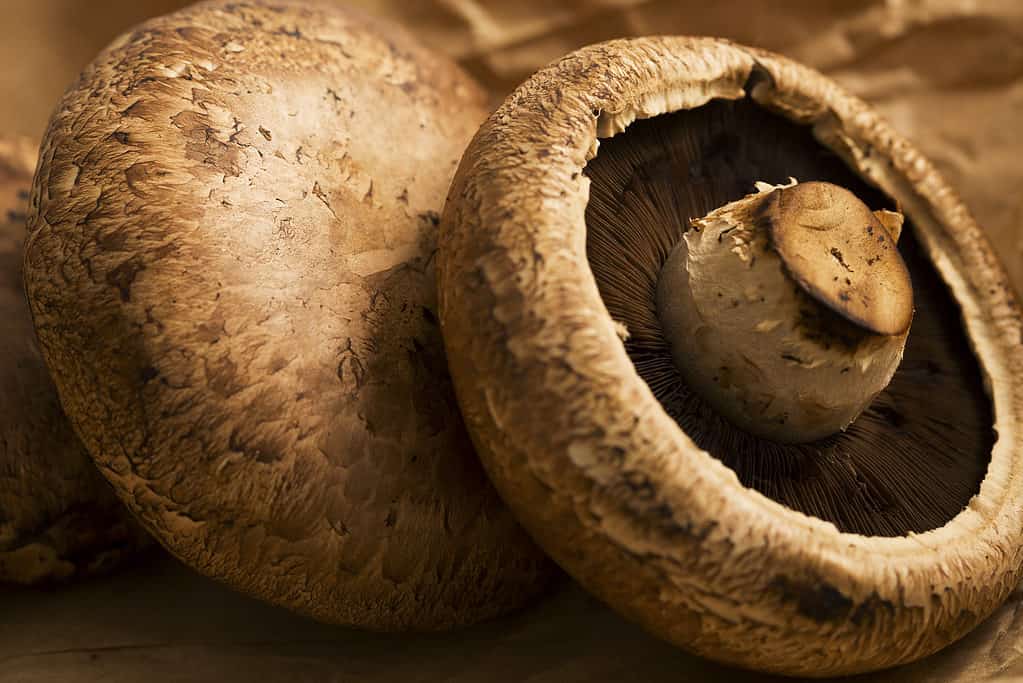
Because both button mushrooms and portobello mushrooms are
Agaricus bisporus, their cultivation is the same for the initial weeks.
©ChoKee/Shutterstock.com
Because button mushrooms and portobello mushrooms are two names for the same fungus, the two share much in common. They share growing and cultivation needs. They appear in similar recipes. Yet there are also a few differences between button and portobello mushrooms. They have some different uses in cooking and culinary history, different flavors, and obvious differences in appearance and size. Let’s explore the ways in which they are similar and different in greater detail now!
Button Mushrooms vs. Portobello Mushrooms: History
Humans have harvested mushrooms from the wild for thousands of years. Additionally, humans have long cultivated various mushroom species to eat and use in traditional medicine. However, the cultivation of Agaricus bisporus in Europe can be traced to much more recently. In the late 1500s and early 1600s, commercial production really took off. Though Agaricus bisporus grows natively in the cooler climates of Asia, Europe, and North America, you can find these mushrooms grown across the world in both indoor and outdoor environments. Because this species is one of the most widely-consumed mushroom species in the world, there is wide-scale production in countries like the U.S. and Canada, parts of western Europe, and many countries in Asia, including India, Korea, Indonesia, and Taiwan.
Today, the cultivation of Agaricus bisporus is a billion-dollar industry in the United States, and both button mushrooms and portobello mushrooms are wildly popular. However, button mushrooms are consumed on a much grander scale than portobellos, with some estimates stating that as much as 90% of mushroom consumption in the U.S. are of button mushrooms.
Button Mushrooms vs. Portobello Mushrooms: Appearance
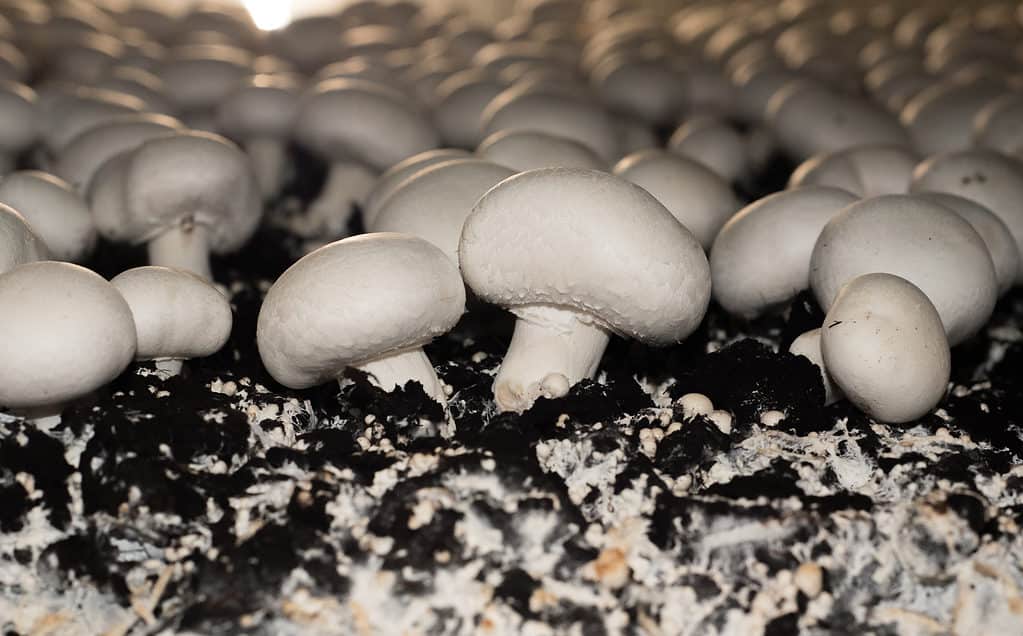
The main difference in the cultivation of button mushrooms compared with portobello mushrooms is when they are harvested.
©ArliftAtoz2205/Shutterstock.com
Appearance of Button Mushrooms
When harvested at its youngest stage, Agaricus bisporus goes by the name of “button mushroom” as well as “white mushroom,” “common white mushroom,” or “white button mushroom.” Each of these names refer to the typically white or pale tan color of button mushrooms at the time of harvest. At that point, the mushrooms had grown for only a few weeks. At that point, they are very tiny. Some of them reach only half an inch across at the point of harvest. Others achieve a few inches in diameter of growth. At this point of maturity, the mushrooms have smooth caps. These caps curl over, hiding light brown gills underneath their edges.
As the mushroom matures, it will begin to unfurl and reveal these brown gills, which produce dark brown spores. The flesh of the button mushroom is firm to the touch while remaining slightly sponge-like. The stems have a similar texture and are white or cream in color. because of their pale, ivory color. They can be very tiny or as large as 3 inches in diameter. These mushrooms have smooth and rounded top caps, with flesh that is slightly sponge-like while staying firm. Underneath the caps are light brown gills, which produce dark brown spores. The stems are short and white.
Appearance of Portobello Mushrooms
Portobello mushrooms have less-descriptive names, with the main variation coming in spelling (“portabella,” “portobello,” and “portabella”). Portobello mushrooms are much larger and have caps that are dark brown. As the mushroom matures, its cap grows, unfurls to reveal gills underneath, and deepens in color. While button mushrooms may be white to tan, the mature portobello has developed into dark brown. If you flip it upside down, you may find that it has openly-revealed gills, which are dark brown. The stems are off-white or tan, and while they are still technically edible, but tougher and more woody than those of a button mushroom.
Button Mushrooms vs. Portobello Mushrooms: Growing Conditions

Button mushrooms can be harvested much sooner than portobellos.
©PIXbank CZ/Shutterstock.com
Because both button mushrooms and portobello mushrooms are Agaricus bisporus, their cultivation is the same for the initial weeks. Agaricus bisporus grows well in grassy areas such as fields or meadows. Traditionally, when they grew naturally in the wild, the mushrooms would spring up in pastures rich in cow or horse manure. Fields with damp, nitrogen-rich soil provided a good environment for them to spawn and develop a web of mycelium.
Today, cultivators replicate these conditions by providing soil around 70 degrees Fahrenheit, manure or compost-rich dirt, and moisture.
The main difference in the cultivation of button mushrooms compared with portobello mushrooms is when they are harvested. Button mushrooms can be harvested much sooner than portobellos. They are often harvested as soon as seven to 14 days after sprouting from the mycelium. In contrast, portobello mushrooms take weeks to grow and mature. Because of this, individual portobello mushrooms are more expensive to purchase at a grocery store, due to the extended timeframe for cultivating them.
Button Mushrooms vs. Portobello Mushrooms: Taste
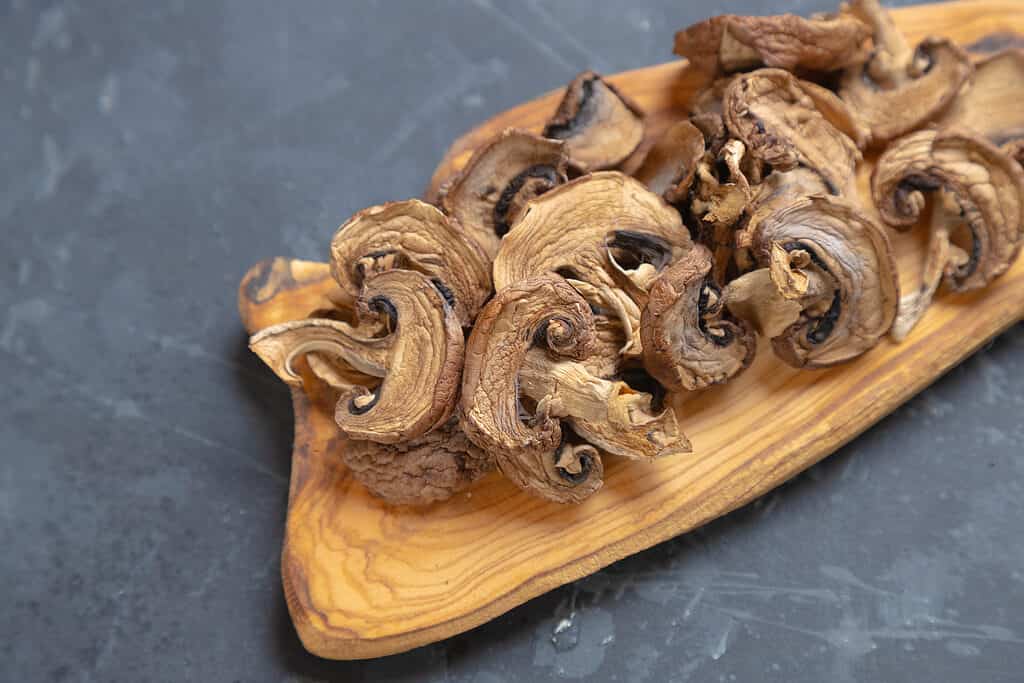
Unlike button mushrooms, the stems and gills of large portobello mushrooms are not very delicious.
©Igor Dutina/Shutterstock.com
Of the three stages of maturity at which Agaricus bisporus is harvested, button mushrooms have the mildest flavor. This contributes to their popularity among all mushrooms because they have only a slightly earthy taste and have a pleasant chewy texture that is not rubbery and remains tender. All parts of the button mushroom is edible – cap, gills, and stem. At their early age of maturity, these individual parts will have a similar texture and taste equally good raw or cooked. You may also choose to dehydrate them and add back into soups or stews as a dried ingredient.
In comparison, portobello mushrooms have a strong earthy taste and bring a rich flavor to soups and stews. Because of their size and tender, but dense and almost meat-like texture, portobellos are often used as a meat substitute – either on their own or in recipes. However, unlike button mushrooms, the stems and gills of large portobello mushrooms are not very delicious. Though they are technically edible and are not harmful to consume, the stems tend to be fibrous and unpleasant to chew and have a more bland flavor. The dark brown gills also tend to impart a dark brown color to food, so cooks tend to remove both the gills and stem before cooking and serving portobellos.
Button Mushrooms vs. Portobello Mushrooms: Uses
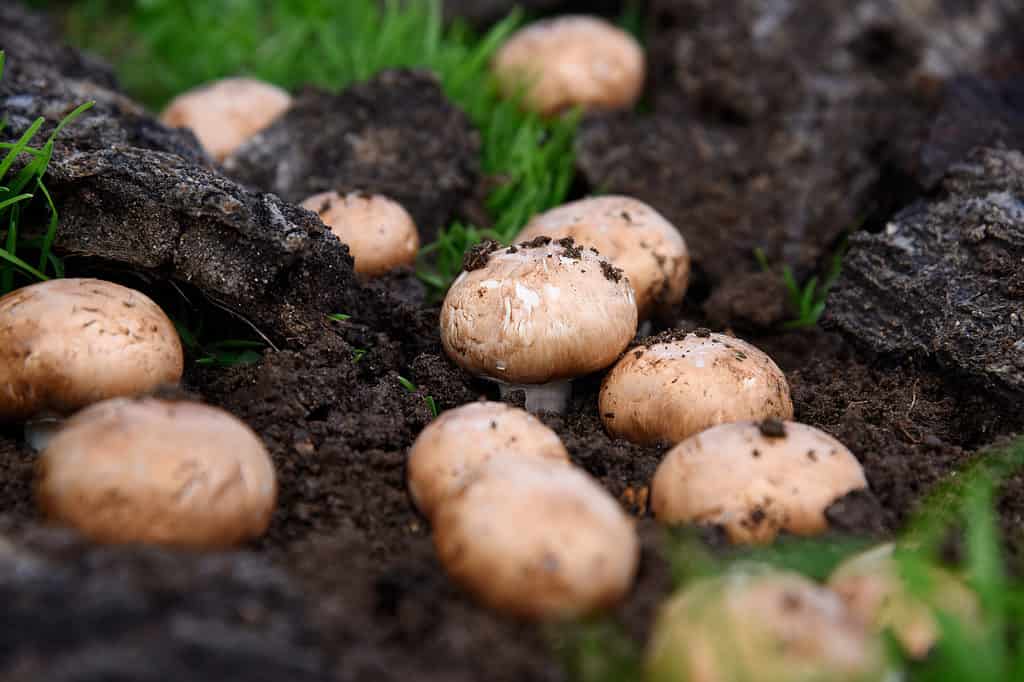
Both button mushrooms and portobello mushrooms should be stored in the refrigerator.
©Wild As Light/Shutterstock.com
If you would like to try cooking with mushrooms for the first time, you can try using a brush or damp cloth to gently wipe away any dirt or debris before cooking. Some cooks recommend not washing your mushrooms, for fear of saturating the sponge-like mushroom and causing it to become mushy when cooked. Instead, they recommend simply wiping away any dirt and trimming any spots or unnecessary areas. If this makes you squeamish, you may rinse your mushrooms and pat them dry to absorb any remaining water.
Button mushrooms may be eaten whole or chopped, though chefs recommend trimming the tip of the stem. However, you may want to spend more time preparing your portobello mushroom, removing both the stem and the gills before eating.
Button mushrooms are often added to stir fry, soup or stew, salad, or even pizza. They are often combined with other, more flavorful mushrooms. While portobello mushrooms may also be sliced and added to dishes like soups, pasta, or stir fry, they are also grilled or sauteed whole, sometimes with sauce or seasonings as a “vegan burger.” Because they have such a meaty texture and robust flavor, they are also popular as a meat substitute in recipes like tacos or pasta. Try making one of these unique recipes and swap out your meat for a portobello mushroom sometime!
Button Mushrooms vs. Portobello Mushrooms: Storage

In the right conditions, your button and portobello mushrooms can last for days or even more than a week.
©Svetlana Lukienko/Shutterstock.com
Both button mushrooms and portobello mushrooms should be stored in the refrigerator. Some cooks recommend covering them with a towel or storing them in a paper bag. Avoid storing them in plastic containers or disposable plastic bags, which can cause the mushrooms to become soft and slimy – turning inedible much faster than they would otherwise. In the right conditions, your mushrooms can last for days or even more than a week.
In Summary
This article compares button and portobello mushrooms, also known as the fungus Agaricus bisporus at two different stages of maturity. When at its youngest stage, it is called a “button mushroom” and is small, tender, white, and considered mild in flavor. When at its oldest stage, it is called a “portobello mushroom” and is large, brown, earthy, and rich in flavor. Some of the biggest differences between the two are their size, taste, which parts of the mushroom you can use, and the color of the cap. These qualities mean that each one is used for slightly different purposes and can be an enjoyable, delicious food for you to try – either in a recipe or on its own!
Editor’s Note: While A-Z Animals does its best to ensure the accuracy of its content and photography, do not eat wild mushrooms without firsthand knowledge from a local mycologist or mushroom expert as many types of mushrooms look similar.
Next Up
- Are Mushrooms & Other Fungus Plants?
- Death Cap Mushrooms: A Complete Guide
- Russula Mushrooms: A Complete Guide
The photo featured at the top of this post is © PIXbank CZ/Shutterstock.com
The information presented on or through the Website is made available solely for general informational purposes. We do not warrant the accuracy, completeness, or usefulness of this information. Any reliance you place on such information is strictly at your own risk. We disclaim all liability and responsibility arising from any reliance placed on such materials by you or any other visitor to the Website, or by anyone who may be informed of any of its contents. None of the statements or claims on the Website should be taken as medical advice, health advice, or as confirmation that a plant, fungus, or other item is safe for consumption or will provide any health benefits. Anyone considering the health benefits of particular plant, fungus, or other item should first consult with a doctor or other medical professional. The statements made within this Website have not been evaluated by the Food and Drug Administration. These statements are not intended to diagnose, treat, cure or prevent any disease.
Thank you for reading! Have some feedback for us? Contact the AZ Animals editorial team.






